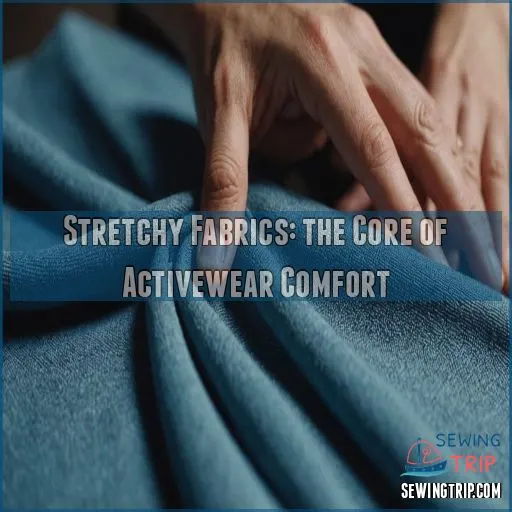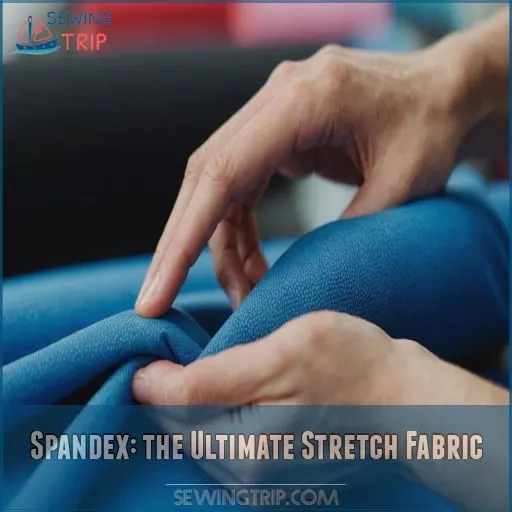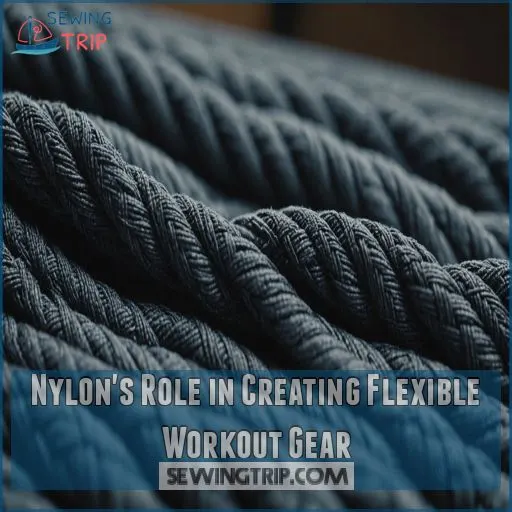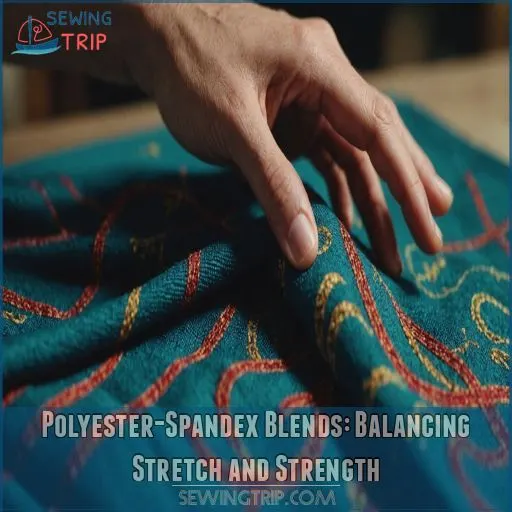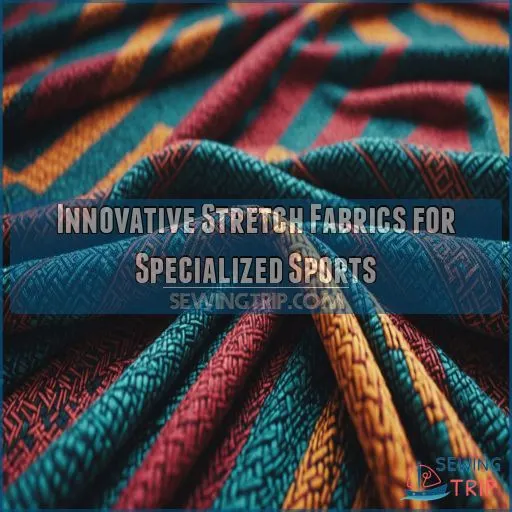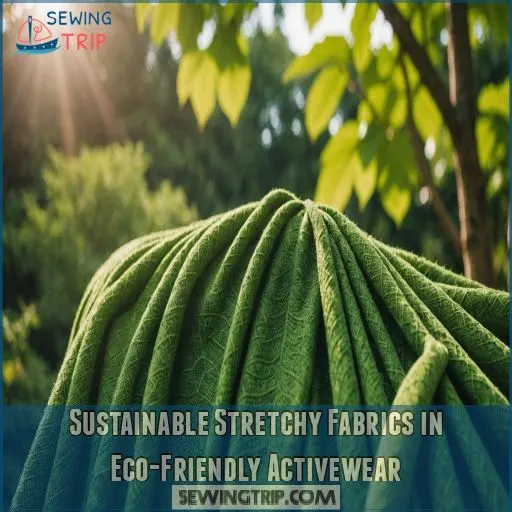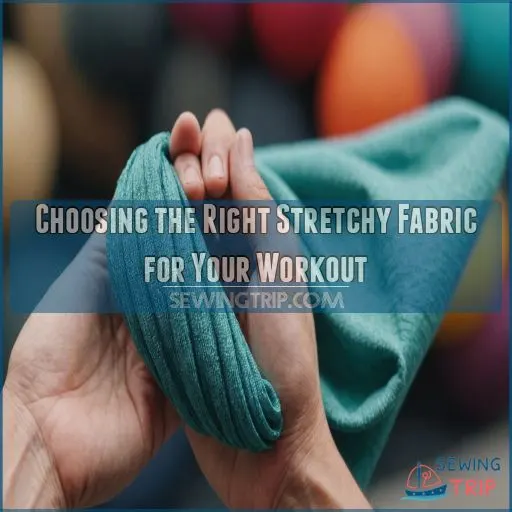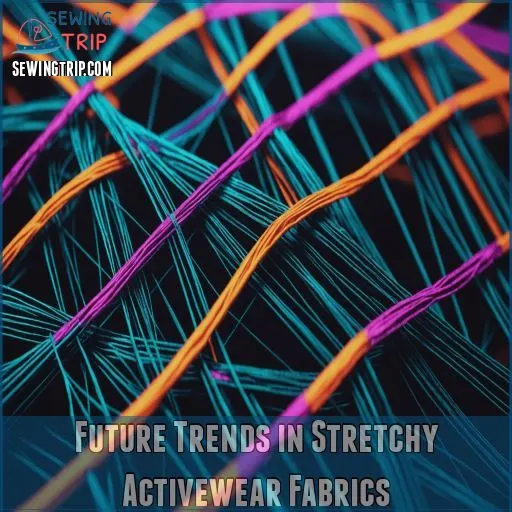This site is supported by our readers. We may earn a commission, at no cost to you, if you purchase through links.
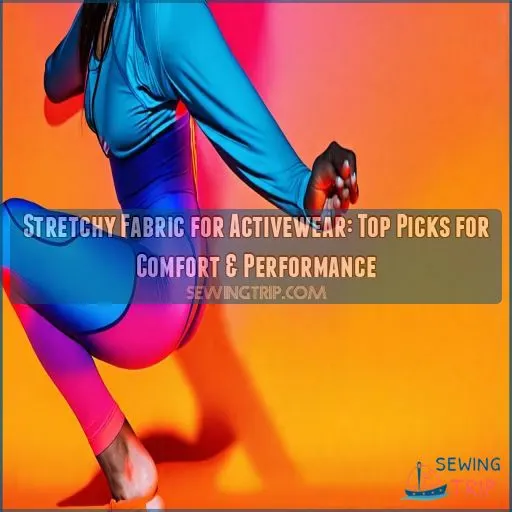
Enter spandex—it’s the superhero of flexibility, stretching up to five times its size and snapping back faster than you can say "workout."
Team it up with polyester or nylon, and you’ve got a fabric dream team that wicks moisture away, keeping you fresh and focused.
Imagine your gym clothes adapting as you move, providing comfort without compromise.
For tips on maximizing these features in your activewear, stay tuned for insights that could transform your workout wardrobe.
Table Of Contents
- Key Takeaways
- Stretchy Fabrics: The Core of Activewear Comfort
- Spandex: The Ultimate Stretch Fabric
- Nylon’s Role in Creating Flexible Workout Gear
- Polyester-Spandex Blends: Balancing Stretch and Strength
- Innovative Stretch Fabrics for Specialized Sports
- Sustainable Stretchy Fabrics in Eco-Friendly Activewear
- Choosing The Right Stretchy Fabric for Your Workout
- Future Trends in Stretchy Activewear Fabrics
- Frequently Asked Questions (FAQs)
- Conclusion
Key Takeaways
- You’ll find that spandex is your go-to for ultimate stretch and recovery, ensuring your activewear moves with you like a second skin.
- Choosing polyester or nylon blends enhances moisture-wicking and breathability, keeping you dry and comfortable during workouts.
- Sustainable activewear options, like recycled polyester, let you enjoy performance gear while minimizing environmental impact.
- Advances in technology, including smart textiles and nanotechnology, are making activewear smarter and more performance-driven.
Stretchy Fabrics: The Core of Activewear Comfort
Stretchy fabrics form the foundation of activewear, offering essential properties like elasticity, moisture-wicking, and breathability that enhance your workout experience.
These materials, designed to move with your body and regulate temperature, provide the comfort and flexibility you need to push your limits and perform at your best.
Elasticity and Recovery Properties
While you’re pushing your limits in the gym, your activewear‘s working overtime too.
Elasticity and recovery properties are the unsung heroes of stretchy fabrics, determining how well your gear bounces back after each rep.
To choose the right fabric for your activewear, consider the different types of stretch fabrics available, such as sheer 4-way stretch spandex types of stretch fabric names.
Spandex, the superhero of stretch, can elongate up to five times its original length without losing shape (Source).
This elasticity isn’t just about comfort; it’s about performance.
A fabric’s recovery rate impacts how quickly it snaps back, affecting both your movement and the garment’s longevity.
Moisture-Wicking Capabilities
Sweat-soaked workout clothes? Not with moisture-wicking fabrics.
These high-tech materials use capillary action to draw sweat away from your skin, keeping you dry and comfortable.
You’ll feel like you’ve got a personal cooling system built into your gear.
Performance fabrics like polyester and nylon excel at moisture management, while innovative options like SeaCell offer added benefits like temperature regulation and nutrient release.
Say goodbye to sticky, clingy workout wear and hello to sweat-free freedom.
Breathability and Ventilation
Keeping your cool during workouts isn’t just about looking good—it’s about performance.
Breathable fabrics are your secret weapon against sweat-induced discomfort.
They work by allowing moisture vapor to escape, keeping you dry and focused.
Here’s how high-quality activewear keeps you feeling fresh:
- Moisture vapor transmission rate (MVTR) measures breathability
- Open knits and looser weaves enhance air flow
- Strategically placed mesh panels boost ventilation
Remember, even the best breathable fabric can’t work miracles in high humidity.
Choose wisely, and you’ll feel like you’re working out in your own personal AC unit.
Durability and Longevity
Your workout gear should be as tough as you are.
Choosing the right fabric, such as nylon and spandex blends for 4-way stretch, is key to a great activewear piece. High-quality stretchy fabrics resist wear and tear, maintaining their shape and performance through countless reps.
Look for blends with polyester for durability and spandex for flexibility.
To prevent shrinkage, it’s essential to avoid high dryer heat and hot water washing, especially with delicate fabrics like Dri-Fit, which can deform from high heat. Proper care extends beyond just washing, follow washing instructions and avoid harsh detergents.
Some brands even use recycled materials, offering sustainability without sacrificing longevity.
With the right fabric and care, your activewear will keep up with your fitness journey, rep after rep.
Odor Resistance and Antimicrobial Features
Considering durability, let’s add odor resistance and antimicrobial features to your fabric checklist.
Antimicrobial fabrics, like those with silver-infused threads or natural agents, tackle sweat smells head-on.
These odor-neutralizing technologies are perfect for team sports or casual wear, offering UV protection and enhancing fabric treatments.
They’re a sustainable solution ideal for outdoor events, keeping you fresh as a daisy.
Spandex: The Ultimate Stretch Fabric
In your quest for the perfect activewear, spandex stands out due to its spectacular stretch abilities and quick recovery, ensuring your clothes move with you like a second skin.
Spandex won’t let you down by losing shape or comfort—almost like having a personal trainer that doesn’t count your rest days.
With its unmatched elasticity, whether you’re doing yoga or just lounging, spandex won’t let you down by losing shape or comfort—almost like having a personal trainer that doesn’t count your rest days.
Composition and Manufacturing Process
Although spandex mightn’t be a magician, its elasticity is quite spellbinding!
This fabric, a polyether-polyurea copolymer, begins life through a careful process of yarn spinning and knitting techniques.
To guarantee high performance, quality control and textile finishing are essential.
Fabric sourcing often traces back to China, where spandex undergoes rigorous scrutiny to meet activewear demands.
Stretch Percentage and Recovery Rate
The stretch percentage and recovery rate are important factors when selecting the ideal stretchy fabric for activewear. A high stretch percentage, often around 40-60%, provides comfortable mobility. Meanwhile, a quick recovery rate prevents bagging and sagging during wear. Look for fabrics that bounce back quickly after being stretched to maintain their shape and support. ,
- Stretch testing methods evaluate the fabric’s ability to stretch and recover.
- Fabric recovery impact determines how well the material retains its original dimensions.
- Performance differences between high and low stretch percentages impact comfort and fit.
- Stretch and comfort are closely linked, with recovery rate affecting overall garment performance.
Blending Spandex With Other Fibers
Spandex blends often bring elasticity and comfort to fabrics, elevating activewear to new heights.
When spandex meets fibers like cotton or polyester, you gain performance benefits such as improved stretch and shape retention.
But blending isn’t without challenges; it’s a bit like mixing oil and water.
Carefully balance fabric combinations for sustainable options that provide both quality and longevity.
Applications in Different Activewear Pieces
Blending spandex with other fibers paves the way for versatile activewear pieces.
Imagine your favorite leggings, sports bras, or yoga pants providing unmatched stretch and comfort.
You’ll appreciate spandex’s adaptability in:
- Shorts: Perfect for flexibility and movement.
- Tops: Provides a snug fit without constraint.
- Yoga Pants: Offers breathability and durability.
These pieces embody performance and style simultaneously.
Care and Maintenance of Spandex Garments
Activewear enthusiasts can extend the life of spandex by following some simple care tips.
Use cold water and a gentle cycle for washing; avoid harsh detergents.
Air-dry clothes or use the dryer on low to prevent fading and stretching.
Skip ironing to maintain integrity, and store garments flat or hung to keep them in top shape (Source).
Delicate fabrics like viscose may require hand or machine wash methods.
Nylon’s Role in Creating Flexible Workout Gear
You’ve probably noticed that nylon in workout gear offers impressive durability and exceptional moisture-wicking abilities, making it a key player in the fitness world.
Its breathability helps keep sweat at bay during intense sessions.
Nylon’s strength doesn’t compromise flexibility, allowing you to move freely, like a yoga master.
When blended with other fibers, it enhances performance and boosts sustainability in eco-friendly activewear.
So, next time you’re stretching into a downward dog, thank nylon for keeping everything in place!
Polyester-Spandex Blends: Balancing Stretch and Strength
When you’re searching for activewear that offers a perfect balance between flexibility and durability, polyester-spandex blends step in as your reliable choice.
These fabrics stretch to accommodate your every move but also maintain their color and shape wash after wash.
Polyester-spandex blends are a wardrobe staple for athletes and casual exercisers alike.
Optimal Blend Ratios for Different Activities
Finding the right polyester-spandex blend is like choosing the perfect partner—each has its unique qualities.
For yoga, opt for 90% polyester and 10% spandex for flexibility and support.
Running leans toward 85/15 for comfort, while swimming demands 80/20 for durability.
Hiking and weightlifting can dance with varied blends, ensuring stretch balances strength for every adventurous step.
Moisture Management Properties
For activewear, polyester-spandex blends are a winning combo.
These fabrics boast superior moisture-wicking properties, pulling sweat away from your skin to keep you feeling fresh and dry, even during the most intense workouts.
The polyester provides strength and durability, while the spandex lends that all-important stretch for unrestricted movement.
Color Retention and Fade Resistance
Polyester-spandex blends shine with superior color retention, thanks to dye sublimation techniques and strong colorfastness testing.
You can laugh at fading worries by following simple washing instructions and fabric treatments.
While environmental factors play a role, these blends resist fading like a champion, making them top picks for vibrant activewear that keeps its hue over long-haul workouts.
Thermal Regulation Capabilities
While color retention keeps your activewear looking vibrant, polyester-spandex blends work wonders at regulating body temperature.
Polyester-spandex blends offer innovations for thermal management, whether you’re facing hot climates or gearing up for cold weather.
They effectively wick sweat during high-intensity activities, ensuring top performance by maintaining comfort and temperature control.
It’s like having a built-in climate control system!
Sustainability Aspects of Polyester-Spandex Blends
Exploring polyester-spandex blends, you find recycled content boosts sustainability, reducing environmental impact by reusing materials like plastic bottles.
Ethical sourcing promotes better practices in production.
While not biodegradable, eco-friendly dyes can minimize harm.
Imagine activewear that’s both effective and responsible—choosing these blends supports a greener future, making each workout a step in the direction of sustainability.
Innovative Stretch Fabrics for Specialized Sports
Imagine your workout gear feeling like a superhero suit, thanks to high-impact stretch fabrics.
When balancing stretch and strength with polyester-spandex blends, you open up a world of sports-specific fabric innovations.
To maximize comfort and performance, understanding how to work with these stretchy materials is key, and learning how to sew athletic material can make all the difference.
Here’s what makes these fabrics game-changers in specialized sports:
- Stretch fabrics for water sports: Stay flexible and warm.
- High-impact stretch fabrics: Perfect for intense activities.
- Stretchy fabrics for winter sports: Keep you cozy.
- Moisture management in stretch fabrics: Stay dry throughout.
- Sports-specific fabric innovations: Designed for your active pursuits.
Sustainable Stretchy Fabrics in Eco-Friendly Activewear
You’re now at the intersection of comfort and sustainability with stretchy fabrics that don’t just fit well—they feel good for the planet too. To prevent stretching and puckering, use a walking foot to ensure even fabric feeding, and they feel good for the planet too.
By using recycled polyester and nylon, as well as innovative bio-based fibers, you can enjoy durable, flexible activewear that supports performance while embracing eco-friendly practices.
Recycled Polyester and Nylon Options
Specialized sports gear often uses eco-friendly fabrics; introducing recycled polyester and nylon offers environmental impact reduction without sacrificing performance.
Derived from plastic bottles and discarded fishing nets, these fabrics excel in moisture management, durability, and breathability.
Consumers increasingly demand sustainable options as they navigate sourcing challenges and recycling processes—all with an eye on performance comparison and perception.
Bio-Based Stretch Fibers
Discover the power of bio-based stretch fibers in your activewear.
Pangaia’s plant-based nylon and corn-derived elastane offer a more sustainable alternative to traditional synthetics, providing the stretch and recovery you crave without the environmental impact.
Explore these cutting-edge materials that blend performance and eco-consciousness for your workout wardrobe.
Circular Economy in Stretch Fabric Production
A circular economy in stretch fabric production lets you reclaim freedom from textile waste.
See the benefits:
- Stretch fabric recycling reduces landfill burdens.
- Textile waste reduction keeps resources in play.
- Closed-loop production boosts sustainability, saving money and the planet.
- Upcycled activewear combines performance with eco-consciousness, so you can flex in more ways than one.
Performance Comparison With Traditional Stretch Fabrics
When you stack sustainable stretchy fabrics against traditional stretch options, several key differences emerge, such as choosing the right needle like a ballpoint or stretch needle. When you stack sustainable stretchy fabrics against traditional stretch options, several key differences emerge.
Sustainable fabrics shine with durability, often matching spandex’s strength, but with lower environmental impact.
While costs can vary, the comfort level remains high.
Functionality doesn’t lag either, as these fabrics maintain flexibility and support, proving you can stretch without stretching the planet’s resources.
Consumer Demand for Sustainable Activewear
You’ve likely noticed that as people compare traditional fabrics, sustainability jumps to the forefront.
Consumers now value eco-friendly materials and ethical production in activewear.
Sustainable brands using recycled fibers meet the increasing demand—even if it means a price premium.
After all, in the quest for greener choices, every runner and yogi becomes a hero of the planet.
Choosing The Right Stretchy Fabric for Your Workout
Choosing the right stretchy fabric for your workout can make all the difference between a session that feels liberating and one that leaves you tangled in your clothes.
Stretchability, moisture-wicking, and breathability are important fabric properties to consider.
By understanding these properties, you can select materials that enhance performance and guarantee maximum comfort no matter how intense your routine gets.
Fabric Properties For Activewear
Picking a stretchy fabric for your workout isn’t just about comfort—it’s about performance, durability, and even sustainability.
Look for materials with a nice balance, offering breathability and moisture-wicking properties.
When your leggings don’t stay dry in a hot yoga class, that’s not ideal.
Opt for fabrics that innovate by incorporating sustainability, ensuring both durability and comfort during those intense workouts.
Top Stretchy Fabric Choices
Finding the right stretchy fabric for your workout is pretty straightforward.
You’re not alone in longing for total comfort and performance.
Consider these options:
- Spandex: Go for ultimate flexibility.
- Nylon Blends: Perfect for durability and breathability.
- Polyester-Spandex: Excellent for stretch and moisture management.
- Sustainable Fabrics: Eco-friendly choices like recycled polyester.
Activity-Specific Material Recommendations
When picking the right stretchy fabric for your workout, consider the activity.
For yoga, opt for low-stretch fabrics like nylon tricot for predictable height and support.
Runners and cyclists prefer high-stretch polyester-spandex blends that wick moisture and move with your body.
Hikers need durable, breathable nylon.
Swimmers thrive in chlorine-resistant polyester.
Find the perfect fit for your fitness routine.
| Activity | Recommended Fabric |
|---|---|
| Yoga | Low-Stretch Nylon Tricot |
| Running/Cycling | High-Stretch Polyester-Spandex Blend |
| Hiking | Durable, Breathable Nylon |
| Swimming | Chlorine-Resistant Polyester |
Future Trends in Stretchy Activewear Fabrics
In the future, you’ll find stretchy activewear fabrics like Liverpool fabric, a double knit fabric with textured right side, embracing cutting-edge innovations, like smart textiles and nanotechnology, to enhance your workout experience.
Imagine fabrics that offer superior comfort and performance but also adjust to your needs with customization and eco-friendly options—it’s like your workout gear hit the gym too!
Smart Textiles and Wearable Technology Integration
You’ve considered fabrics; now, imagine gear smarter than your phone! Smart textiles sync with wearable tech, offering:
- Smart clothing for a sci-fi workout experience.
- Sensors & data to keep tabs on your every move.
- Performance tracking that guarantees you’re on top.
- Biometric monitoring with AI integration for insights galore.
Feeling like a superhero yet?
Nanotechnology in Stretch Fabric Enhancement
Nanotechnology in your activewear fabric plays a pivotal role, enhancing properties like breathability, durability, and moisture-wicking.
When working with these high-tech stretch fabrics, it’s important to choose a stretch stitch that matches the fabric’s stretch percentage, making sewing a more manageable task by how to sew stretchy fabrics without losing your mind.
Imagine tiny superheroes—nanoparticles—providing antimicrobial protection and UV shielding.
| Feature | Benefit | Nanotech Impact |
|---|---|---|
| Breathability | Stay fresh | Increased airflow |
| Durability | Longer lifespan | Reinforced nanoparticle protection |
| Moisture-Wicking | Stay dry | Enhanced performance |
These innovations make your workout more comfortable and enduring.
Customization and 3D-Printed Stretch Materials
Imagine crafting your perfect activewear with 3D-printed stretch materials that offer a personalized fit just for you.
This cutting-edge technology allows athletes to design custom pieces, optimizing both comfort and performance.
Bio-printed fabrics are also on the horizon, promising innovation in stretch materials that can cater precisely to individual needs, making your workout gear as unique as you’re.
Advancements in Comfort and Performance Features
Let’s leap from 3D-printed fabrics to innovations reshaping comfort and performance.
Today’s stretchy activewear isn’t just flexible—it’s a technological marvel!
You’ve got:
- Smart fabrics that adjust to body temperature.
- Breathable materials optimizing airflow.
- Moisture-wicking tech for dry workouts.
- Extensive performance testing ensuring reliability.
These fabric innovations redefine your fitness experience, blending style and science seamlessly.
Sources: ,
Biodegradable and Compostable Stretch Fabrics
Following advancements in comfort and performance, you might explore biodegradable and compostable stretch fabrics for activewear.
These fabrics combine bio-based fibers and eco-friendly stretch to meet sustainability goals.
They break down naturally, minimizing environmental impact while maintaining performance.
By prioritizing textile recycling and sustainable fabric production, you empower your wardrobe and contribute to a greener planet.
Frequently Asked Questions (FAQs)
What makes a good activewear fabric?
Your activewear, like a trusty sidekick, should be moisture-wicking, breathable, and stretchy.
Look for fabrics like nylon or bamboo that keep you dry and comfortable, without those pesky odors, while you conquer your fitness goals.
What are the different types of activewear fabrics?
Activewear fabrics include jersey for its stretch, interlock for thickness and breathability, and mesh for ventilation.
Neoprene offers insulation while tricot boasts durability.
Each fabric has unique features ideal for sports bras, leggings, and jackets.
Who is sew active fabrics?
Sew Active Fabrics, inspired by the owner’s quest, fills a niche in Australia’s fabric market by providing technical performance materials for home sewists.
Laura’s journey means you won’t miss the chance to create your custom activewear masterpiece.
What materials are used in activewear?
In activewear, popular materials include polyester, spandex, and nylon for their stretchiness and durability.
You’ll also find merino wool for warmth and moisture control.
MMCFs like bamboo for a sustainable option.
What is the stretchy athletic material called?
You’ll find the stretchy athletic material is often called spandex or elastane – a synthetic fiber with incredible stretch and recovery capabilities.
It’s commonly blended with polyester or cotton for activewear.
Which fabric is best for a gym workout?
A staggering 90% of athletes prefer moisture-wicking fabrics for comfort.
Combine nylon’s breathability with polyester’s sweat-wicking properties, and you’ve got the perfect duo for any workout.
Just remember, it’s not about the fabric, but how you move! .
What fabric is used for activewear?
Activewear commonly uses fabrics like polyester, nylon, and elastane due to their moisture-wicking, stretchy, and durable properties.
These fabrics provide comfort and flexibility, making them perfect for high-intensity workouts and casual exercises.
What fabric is very stretchy?
Spandex can stretch up to six times its length, ensuring you’re as flexible as a yoga instructor.
It’s perfect for activewear, providing excellent elasticity and recovery.
You’ll feel like you’re wearing a second skin.
How does UV protection impact stretchy fabric?
When choosing stretchy fabrics for activewear, consider the benefits of 4-way stretch fabrics like elastane fabric types which offer multidirectional elasticity. UV protection in stretchy fabrics mitigates sun exposure by incorporating tightly woven materials or UV-blocking chemicals.
Stretching can decrease UV resistance.
A snug yet not overly tight fit is essential for maintaining effectiveness.
Can stretchy activewear be water-resistant?
Nylon, a key fabric in activewear, boasts a 60% increase in water resistance compared to other materials.
While it’s not fully waterproof, it can repel light rain and sweat.
This makes your workouts more comfortable and hassle-free.
Is thermal regulation important for stretchy fabrics?
Thermal regulation’s essential for stretchy fabrics, ensuring comfort across temperatures.
Whether layered or standalone, effective thermoregulation helps you feel like Goldilocks—not too hot, not too cold—enabling ideal performance and comfort in any climate.
How do stretchy fabrics handle frequent washing?
To keep your stretchy fabrics in tip-top shape, use a gentle detergent, wash in cold water, and avoid fabric softeners.
Air-drying or low-heat tumble drying will help preserve the fabric’s elasticity and prevent premature wear.
Are there stretchy fabrics with odor control properties?
Yes, stretchy fabrics like S.Café and Tencel offer odor control.
They combine materials such as coffee grounds or tight-woven fibers to prevent bacteria growth and manage moisture effectively.
This makes them great for staying fresh (Source).
Conclusion
Imagine transforming your workout routine with stretchy fabric for activewear that feels incredible and performs miracles.
You’ve got spandex lending its superhero elasticity, nylon ensuring durability, and polyester-blends offering moisture-wicking comfort.
By smartly choosing these materials, you boost your comfort and performance in every move.
Explore sustainable options, smart textiles, and future trends to keep your activewear game strong.
Ready to leap into action with fabrics that truly stretch the limits?

